For almost a century, General Motors was the top-selling vehicle manufacturer in the United States. In 2021, Toyota took the top spot selling 2.33 million vehicles. The Japanese company sells more vehicles than any other manufacturer in the world and is second in Canada behind Ford. Part of its success in 2021 was because of how it handled the chip shortage compared to some major rivals, but part is because of its more than six decades learning what North Americans want to drive.
Toyota broke into the North American market in 1958 with a sedan that barely sold, but went on to see success by breaking ground and introducing vehicles that had never been seen before in this market. That list includes vehicles from small, fuel-sipping sedans to practical minivans and from stunning sports cars to the world’s first mass-produced hybrid gas-electric vehicle. Here’s a peek at ten classics nestled in a rare historic museum at Toyota Motor North America’s headquarters in Plano, Texas.
1958 Toyopet Crown

Petrina Gentile/The Globe and Mail
Toyota’s first crack into the North American market came with the 1958 Toyopet Crown. It was the first Toyota passenger car sold in the U.S. Powered by a 65-horsepower, 4-cylinder engine mated to a three-speed manual transmission, it had a top speed of 120 kilometres per hour. The price tag was US$1,989. Unfortunately, it wasn’t a big hit in the U.S. By the end of 1960, only 1,913 were sold and Toyota pulled the plug on Toyopet imports.
1966 Corona

Petrina Gentile/The Globe and Mail
The 1966 Corona was an instant success compared to the Toyopet Crown. It was a small car designed for North American drivers. It came loaded with novel features for a compact car including armrests, sun visors, tinted glass, a glove compartment, full carpeting and white sidewall tires. The four-door model sold for US$1,760. It was the first Toyota vehicle to sell more than 10,000 units in a year in the U.S.
1967 2000GT
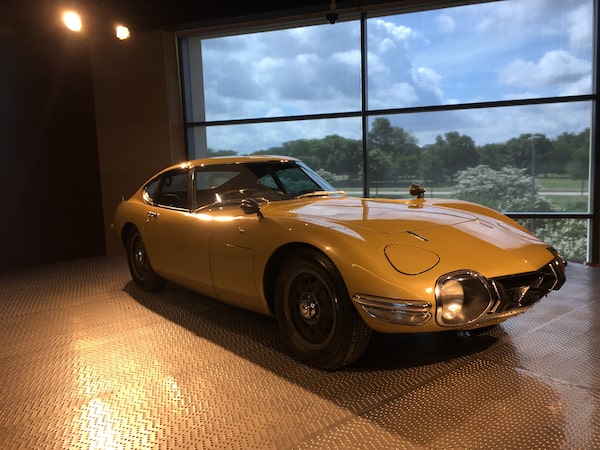
Petrina Gentile/The Globe and Mail
The 2000GT was made famous in the 1967 James Bond flick You Only Live Twice. Designed specifically for racing, it was the first true high-performance sports car from a Japanese automaker. The rear-wheel-drive vehicle had a 150-horsepower, six-cylinder engine mated to a five-speed manual transmission. It cost $7,230 and the production run was limited. From 1967 to 1968, 337 were built and only 54 of those were imported into North America. Today, this gold version is worth a fortune – it’s one of only two 2000GTs painted gold for the 1967 Toyota Motor Show.
1972 Corona

Petrina Gentile/The Globe and Mail
1970 marked the introduction of the fourth-generation Corona. It hit the streets amid an era plagued with oil shortages and inflation so it was no surprise Toyota’s fuel-sipping sedans were an instant hit. Corona’s lineup expanded quickly from two to five models. All versions came with a new bandless automatic transmission that shifted more smoothly, accelerated faster and was more durable than the last system. The price was US$2,532.
1977 Celica GT

Petrina Gentile/The Globe and Mail
Move over Mustang and Charger – Toyota’s answer to the popular American pony cars of the 1960s and 70s was the Celica two-door coupe. This stylish body was built on a sedan platform and designed by Calty Design Research in Newport Beach, Calif. Performance features included wide radial tires, chrome trim wheels, dual racing mirrors, power font disc brakes and a MacPherson front strut suspension for taking tight turns quickly. It was powered by a 95 horsepower 2.2-litre four-cylinder engine and three-speed automatic transmission. All for US$4,699.
1983 Camry
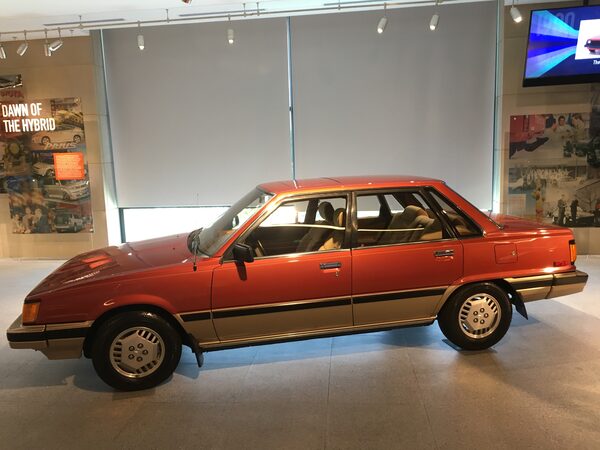
Petrina Gentile/The Globe and Mail
Camry hit the streets in 1983 as a four-door sedan and a five-door hatchback designed to replace the Corona. It was a smash hit and quickly became the most recognized nameplate in Toyota’s lineup. It has been one of the best-selling passenger cars in North America for two decades now. It originally sold for US$7,798. In 2007, Camry was also the first vehicle built by an international manufacturer to compete in the Nascar Nextel Cup Series.
1984 Van Wagon
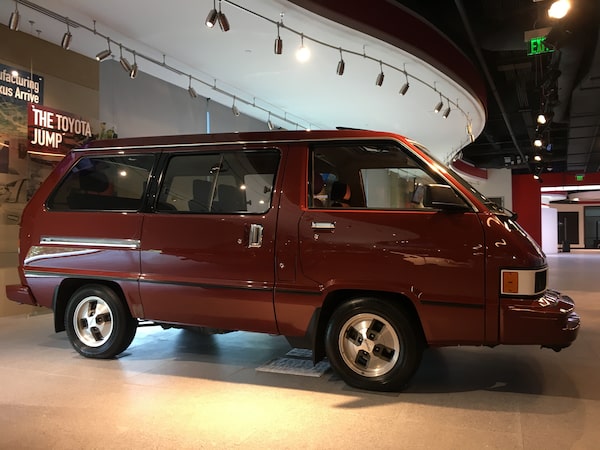
Petrina Gentile/The Globe and Mail
In 1984, the minivan segment was born. Toyota entered the market with its version called simply “Van” in North America – in the U.K. it was named the “Space Cruiser”. Revolutionary in its design, it had many features still seen today including dual sunroofs, removable seats, a built-in ice-maker, and a mid-engine rear-wheel-drive design. With nearly 100,000-kilometre service intervals, the Van was popular with families and sealed Toyota’s quality and reliability reputation. It cost US$8,998.
2001 Prius
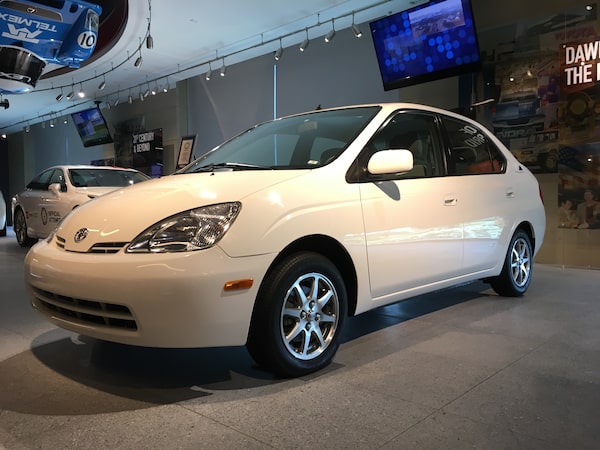
Petrina Gentile/The Globe and Mail
Toyota changed the game environmentally when it launched the 2001 Prius, the world’s first mass-produced hybrid gas-electric vehicle. The 70-horsepower, 1.5-litre gas engine coupled to a 25-kilowatt 34-horsepower battery pack and a four-speed automatic transmission enabled the Prius to run on gas or electric power alone. It also returned unprecedented fuel economy numbers – approximately five litres per 100 kilometres combined highway and city driving. Retail price was US$19,995.
2006 F3R Concept

Petrina Gentile/The Globe and Mail
Toyota was ahead of its time with this cool concept, the F3R, which stood for Freedom Three-Row concept vehicle. Designed in California, the F3R was aimed at attracting younger buyers who didn’t want to be seen driving an “uncool” minivan. So, Calty designers created a hybrid-powered upscale lifestyle lounge vehicle with three rows of seats that was unique, spacious and a fairly accurate glimpse of the future.
2021 Mirai
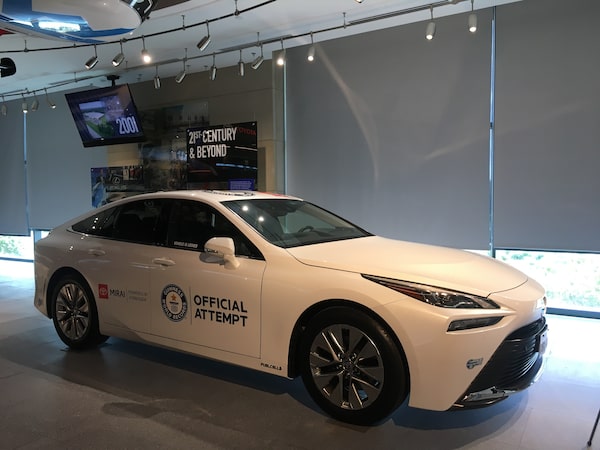
Petrina Gentile/The Globe and Mail
Toyota drove into the history books with the 2021 Mirai, officially entering the Guinness World Records on Oct. 8, 2021. It won the title for driving the longest distance by a hydrogen fuel-cell electric vehicle without refuelling. In total, the Mirai travelled 1,360.378 kilometres on a single, five-minute complete fill of hydrogen during a round-trip tour of Southern California on Aug. 23-24, 2021.
Shopping for a new car? Check out the Globe Drive Build and Price Tool to see the latest discounts, rebates and rates on new cars, trucks and SUVs. Click here to get your price.